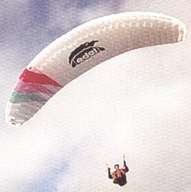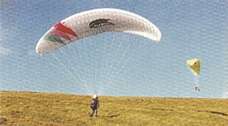| enginuity |
|
On a wing and a prayer
Not everyone relishes the prospect of jumping off the side of a mountain, attached to what is effectively an overgrown kite, but the sport of paragliding is attracting an increasing number of people, with around 4,000 qualified pilots now in the UK. As the competitive aspects of the sport increase, pilots compete for both distance and speed records and the design of the paraglider wing has been evolving to make more competitive products. 'In my view, the improvements in design, which have, until now, been made on a trial-and-error basis, are at a point when they are becoming critical', comments Dr Holger Babinsky.

'The frightening thing is that competition pilots often push their gliders to operate at high speeds and low angle of attack, thus, according to our results, very close to collapse conditions. Any small gust can cause the wing to suddenly deflate.' With stories of wings collapsing and failure of the re-inflation techniques becoming more frequent, it is no wonder that safer design of paraglider wings has become a popular option for fourth-year student (many of whom are qualified paraglider pilots) for their final-year research projects.
'There is always a trade-off between performance and handling characteristics,' explains Dr Babinsky, 'so we need to understand the mechanism of collapse, to make paragliders safer without degrading the performance.'
Aerodynamics research
Dr Babinsky more usually researches the aerodynamics of supersonic flight; however, he started this work for a fourth-year undergraduate project three years ago. Since then, he has had a total of ten students working on it who have produced a vast volume of research data under his enthusiastic direction. 'The curved wing of a paraglider is shaped like an airbed, fully flexible and kept inflated by the air intake. Unlike an aircraft wing, this shape of a paraglider wing changes as it flies. By building a wing model with a flexible sheath, the students have discovered that the effect of the grooves in the wing is to increase the drag and reduce the lift. This year, we have, for the first time understood the aerodynamic causes of this behaviour and, as a result, have suggested a number of design improvements, such stiffeners in the wing, and slots in the trailing edge. Although neither of these design changes has been optimised, they each give a 10-15% improvement in lift-to-drag ratio, without creating a safety problem.'

'With over 50% of the fourth-year students who have undertaken project work on this topic being active paraglider pilots, they have an understandable enthusiasm for their research, and have produced an amazing volume of research data in this field. It is very pleasing that we can take the student projects to a point where they are useful,' comments Dr Babinsky. There must be many paraglider pilots who echo his sentiment. The work, to date, has used an old-style wing for research but future projects hope to examine an up-to-date competitive model.
Further information is available from Dr Holger Babinsky, Tel: 01223 339721.
| number 7, December '98 |